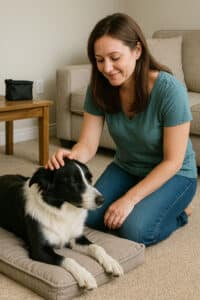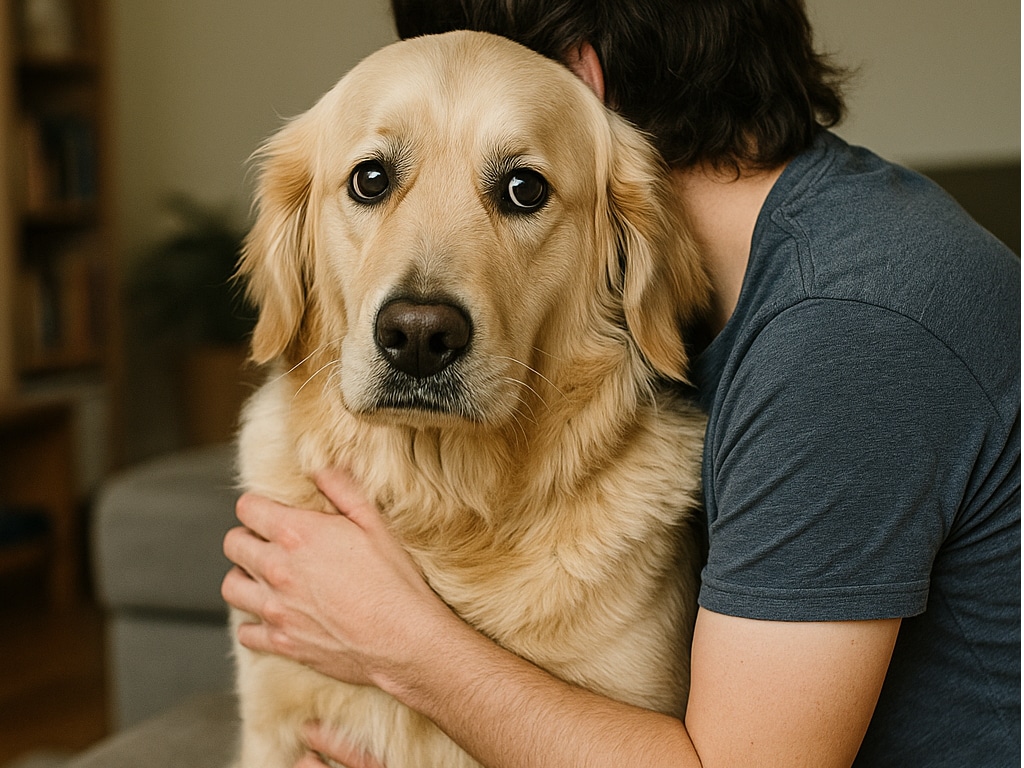The Missing Piece in Most Dog Households: It’s Not Love, It’s Leadership
When people think of bringing a dog into their lives, their minds immediately go to affection. The snuggles, the loyalty, the emotional connection—that powerful bond we dream of is built on love. But here’s the uncomfortable truth: love, in isolation, often creates confusion, not connection. And in the world of dog training, confusion is the seed from which nearly all behaviour issues grow. It’s not that affection is wrong. It’s that affection alone is incomplete.
If you’re a first-time dog owner looking for real guidance—not fluff—you need to understand this from day one: your dog doesn’t need a best friend. Your dog needs a guide. Someone who knows when to say yes, when to say no, and most importantly, when to say nothing at all. Because silence is feedback. Space is feedback. Calmness is feedback. And your ability to balance affection with clear, calm, consistent boundaries will determine whether your relationship becomes one of mutual respect—or mutual frustration.
At K9 Principles, we’ve worked with families all across the greater Hamilton area who were drowning in love but starving for clarity. They had dogs who barked, lunged, destroyed furniture, cried when left alone, growled at guests—dogs who were adored beyond measure but overwhelmed by the lack of structure. This article is for them. It’s for you. And it’s written to give you the most thorough, honest, and effective roadmap to creating a healthy, respectful, and loving relationship that lasts a lifetime.
Let’s Get Something Straight: Dogs Are Emotional, Not Rational
Before we dive into technique, let’s talk about species. Dogs are not humans in furry suits. They do not reason. They do not negotiate. They do not ponder moral questions. What they do is respond—moment to moment—to the environment, the energy, and the patterns you create.
Dogs are emotional learners. They associate feelings with actions. So if they feel aroused and bark, and you soothe them with a cuddle, they learn that barking earns physical closeness. If they jump up and you giggle or push them away playfully, they learn that jumping gets a response. They don’t see the behaviour as “bad.” They see it as effective.
This is why dog training in Hamilton must start with emotional clarity. You’re not just teaching behaviours. You’re teaching emotional regulation. When your dog is calm, they can learn. When they’re spinning in excitement, frustration, or uncertainty, learning shuts down—and instinct takes over. If you pour affection into a dysregulated dog, you’re reinforcing chaos. And chaos breeds more chaos.
The Neurology of Affection: Why Timing Is Everything
Affection lights up the brain. Oxytocin, serotonin, dopamine—all the feel-good chemicals flood the system during close contact. For humans, this creates bonding. For dogs, it does too—but with one key difference: the state they’re in when the affection lands becomes chemically linked to the reward.
This is why timing matters. If your dog is barking at the postman and you pick them up to soothe them, you’ve now associated those feel-good chemicals with an unstable state. The brain thinks, “That felt good—do that again.” That’s why the behaviour returns stronger next time. It’s not because your dog is defiant. It’s because the chemistry of affection accidentally reinforced the wrong mindset.
At K9 Principles, we teach owners how to make affection a marker of calmness—not a reaction to chaos. You don’t need to remove affection. You need to reframe it. Think of it like seasoning a meal—perfect when used sparingly and purposefully, but overwhelming if dumped in without care.
Dogs Crave Structure the Way Children Crave Sleep
This might seem strange, but dogs—especially those under two years of age—behave almost identically to toddlers in their emotional needs. They test limits. They seek comfort. They thrive with routine. And they fall apart when they’re overstimulated.
A toddler who’s overtired doesn’t need another toy or another snack. They need boundaries. A clear bedtime. A quiet space. A strong, confident adult to say, “Enough.” The same goes for dogs. They don’t need constant access to the sofa, to your lap, to your attention. They need predictability. They need decisions made for them. And when you do that consistently, you become their anchor—not their servant.
This is the foundation of our Hamilton dog training model: predictability creates safety. Safety creates calmness. Calmness creates compliance. And compliance, when built on trust—not fear—is the holy grail of long-term behaviour change.
The Cost of Unfiltered Affection: Clinginess, Insecurity, and Emotional Dependency
Many new dog owners confuse affection with emotional support. They believe that every time their dog is anxious or vocal or restless, they need to do something. But here’s what we’ve seen time and again in private sessions: dogs that are over-touched, over-soothed, and never allowed to struggle safely become emotionally fragile.
They don’t know how to be alone. They can’t regulate themselves. They bark the moment you leave the room, or worse—they destroy something to self-soothe. And the irony is, the more affection they’re given in those moments, the more their dependency grows. You’re not creating resilience. You’re creating reliance.
One of the most powerful lessons we teach during dog training in Hamilton is how to create confident independence. That starts with boundaries. Not harsh ones. Not punitive ones. But simple, reliable, repeatable boundaries. Place work. Wait at thresholds. Delayed greetings. These aren’t rules for the sake of control. They’re tools for building emotional tolerance. And emotional tolerance is what allows your dog to navigate the real world without melting down every time life doesn’t go their way.

Training Is More Than Cues—It’s an Emotional Agreement
When most people think of dog training, they think of cues: sit, down, come, stay. But real training—the kind that sticks—is emotional. It’s the agreement you make with your dog: “You listen to me not because I force you, but because I make sense to you.”
This is why affection without structure is so damaging. It breaks the agreement. It creates mixed signals. One moment you’re laughing at the jumping, the next you’re yelling at it. One day they’re allowed on the couch, the next day they’re punished for it. Dogs don’t understand the switch. They only understand consistency.
At K9 Principles, our goal isn’t to micromanage your dog. It’s to build a communication system that’s fair. That system relies on two things: consistency and clarity. And when those are in place, your dog doesn’t just behave—they begin to offer behaviour, because they feel safe, confident, and emotionally aligned with you.
Affection Is Earned, Not Entitled
This is a hard mindset shift for many people. “But I love my dog—I want to give them affection all the time!” You can. But make them earn it. Not in a cold, transactional way. In a calm, communicative way.
Here’s what that looks like: your dog offers a calm sit before you clip the lead on. They wait patiently while you prep their food. They settle on their bed while you watch TV. Each of those moments is an opportunity to reinforce stability with affection. You’re not withholding love—you’re making it meaningful. You’re saying, “This calmness? This focus? This is what gets my touch.” That’s the kind of clarity dogs crave.
If you smother your dog with affection regardless of their state, it loses its meaning. It becomes white noise. But when affection is tied to regulation and responsiveness, it becomes a language of reward that deepens your bond and sharpens your training results.

Boundaries Without Emotion: The Art of Neutral Correction
Many people misunderstand what a “correction” looks like in modern dog training. It’s not yelling. It’s not punishment. It’s not emotional. It’s just information. Dogs don’t take neutral guidance personally. They don’t sulk over fair boundaries. They respond, recalibrate, and move on.
Let’s say your dog is pawing at you during dinner. A neutral boundary might be a gentle spatial block, a redirection to a bed, and a reward for calmness. No drama. No frustration. Just “This is not available right now.” And over time, your dog learns that pushiness gets ignored—but calmness gets access. That’s not suppression. That’s education.
We train every one of our Hamilton dog training clients to use their body, their timing, and their energy to guide—not force—their dogs. You don’t need more tools. You need more awareness. Most of the correction your dog needs can be done without a single word, if your timing is sharp and your energy is stable.

Why Saying “No” Is an Act of Compassion, Not Control
We live in a culture that often sees saying “no” as cruel. But dogs don’t carry that emotional baggage. They don’t need constant yeses to feel loved—they need clear markers of what works and what doesn’t. A calm, fair “no” doesn’t damage trust. It builds it. Because when your dog understands where the line is, they can stop guessing. And when they stop guessing, they stop stressing.
Imagine trying to navigate a game where the rules change constantly. That’s what life feels like to a dog in a house with no boundaries. One day jumping gets attention, the next day it gets scolding. One moment they’re allowed to bark out the window, the next you’re yelling at them to stop. Without consistency, there’s only confusion—and confused dogs become chaotic dogs.
At K9 Principles, we teach you how to say “no” in a way that doesn’t need to be loud or forceful. A clear marker. A pause in the interaction. A physical redirection. Saying “no” doesn’t mean you don’t love your dog. It means you love them enough to teach them how to live in your world with confidence and calmness.
Creating Space: The Most Underrated Training Tool in the World
Everyone talks about food, toys, praise—but let’s talk about space. Space is information. It’s feedback. It tells your dog whether they’re being invited in or asked to pause. It defines social rules. It gives context to your body language. And in many cases, it does more to shape behaviour than any treat ever could.
When your dog is crowding you, leaning on you, pawing for attention—your instinct might be to pet them. But try this: take a breath, shift your body, and create space. Step into them calmly. Use your posture to say, “Not now.” Then, when they choose to give space or settle on their own, that’s when you mark and reinforce. You’re not rejecting them—you’re communicating with clarity.
We incorporate this deeply into our dog training in Hamilton because it teaches both the dog and the human how to respect each other’s space. It resets the energy. And most importantly, it helps dogs learn that presence doesn’t always mean interaction. That’s a powerful lesson—especially for dogs prone to overexcitement or separation anxiety.
Why Dogs Thrive on Delayed Gratification
Instant gratification is everywhere in human culture. But dogs don’t need everything now. In fact, dogs who get everything immediately—treats, affection, access—tend to struggle more with frustration, control, and calmness. They’re used to reacting, not waiting. And waiting is where the real magic happens in dog training.
Teach your dog to pause at thresholds. To wait for a release cue before eating. To hold eye contact before earning a pat. These aren’t just cute obedience tricks. They’re exercises in self-regulation. They teach your dog to think before acting. That is the true foundation of emotional control.
And when you combine delayed gratification with affection, it becomes exponentially more powerful. Your dog doesn’t just learn to wait—they learn that calm waiting earns the best outcomes. That lesson creates dogs who are not only obedient but emotionally balanced. And that’s what transforms your household—not just your heel cue.
Affection Is the Finish Line, Not the Starting Gun
This mindset shift will change your training journey forever: affection should come after success, not before it. Most dog owners start with affection, hoping it will motivate calmness. But it’s backward. You don’t use affection to settle a dog. You use affection to mark that they’ve already settled.
Let’s say you’re coming home from work. Your dog is losing their mind at the door. Most people would greet the chaos. But that only tells the dog, “This energy gets me connection.” Instead, walk in, stay neutral, and wait. When the dog pauses, offers stillness, or even just a calmer look—that’s when you greet. Now you’ve reinforced composure, not chaos.
This small change is one of the most powerful tools we teach at K9 Principles. It flips the emotional script. It tells your dog, “I see you. I love you. But I also need you calm.” And over time, your dog learns that the best things in life come not to the loudest—but to the most regulated.
The Trap of Guilt-Based Training
Let’s address the emotional side of this. Many owners struggle to set boundaries because they feel guilty. Guilty about crate time. Guilty about not petting. Guilty about saying “no.” But here’s the truth: guilt makes you reactive, not responsible.
Dogs don’t need you to feel sorry for them. They need you to feel stable around them. They need your decisions to come from clarity, not emotion. At K9 Principles, we remind every client: your dog doesn’t benefit from your guilt—they benefit from your growth.
The moment you let go of guilt and replace it with purpose, your entire relationship changes. You become more grounded. Your dog becomes more settled. And the emotional whirlwind that once defined your household begins to calm.
The Long-Term Payoff of Balanced Dog Training
Let’s zoom out. What happens when you consistently balance affection with boundaries? You get a dog who knows when to offer calmness. Who doesn’t panic when you leave the room. Who doesn’t explode at the front door or whine for attention. You get a dog who listens not because they’re afraid, but because they’re connected to you emotionally and behaviourally.
That’s what dog training in Hamilton should be. Not a series of tricks. Not a boot camp. A relationship. Built on trust. Reinforced by routine. Made resilient by mutual understanding. And when you get that part right, everything else falls into place. Walks become peaceful. Guests become non-events. Your home becomes a sanctuary—not a circus.
This isn’t just about training your dog. It’s about becoming the kind of person your dog can count on. And that starts by understanding that boundaries are affection. They’re just the kind that teaches, rather than soothes.
Final Thoughts: When You Lead, Your Dog Can Rest
The greatest gift you can give your dog is not your love. It’s your leadership. Because when you lead, your dog can rest. They can stop worrying. Stop reacting. Stop trying to control a world they don’t understand.
That’s what real dog training looks like. And that’s exactly what we do at K9 Principles. We don’t just fix problems—we build partnerships. We don’t just teach obedience—we create emotional literacy. And we don’t just give dogs affection—we show them how to earn it, hold it, and trust it.
If you’re a new dog owner in Hamilton, don’t wait until things unravel. Start building the right relationship from day one. And remember: balance isn’t just possible. It’s transformational.
That’s real dog training. And it starts right here.
Contact us for more information:
- Name: K9 Principles
- Address: Haldimand County, Greater Hamilton Area, Burlington, and Most of Norfolk County
- Phone: 289 880-3382
- Email: k9principlesinc@gmail.com
- Website: www.k9principles.ca
FAQs
-
A1. Not if you want to build calmness. Wait until your dog settles, then reward that emotional state with affection.






